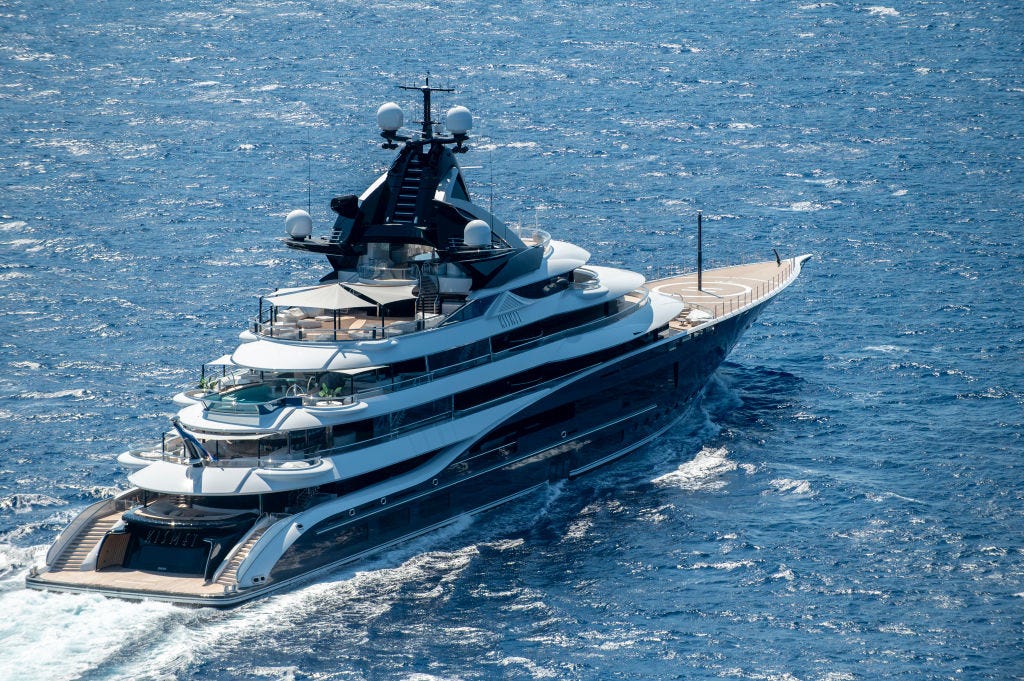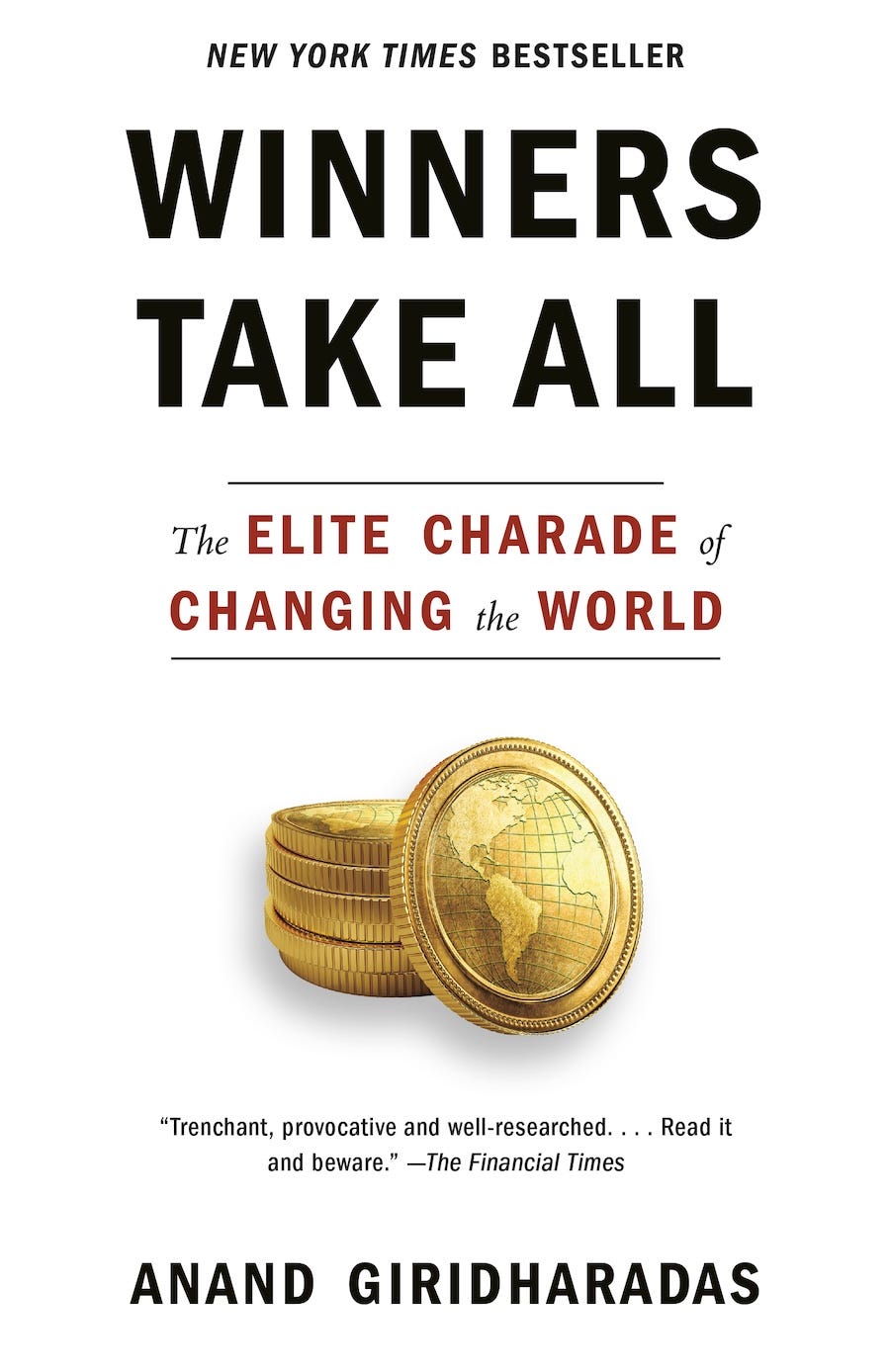SUMMER READING: Rebel-kings in worrisome berets
A luxury cruise opens a window on the floating world of borderless capital and its promises, in a look back at "Winners Take All"
How much is too much? And if there’s never enough, how can it possibly be justified?
Earlier this week, we spoke with the journalist Evan Osnos, whose new book, The Haves and Have-Yachts, opens with an essay exploring the hidden floating world of extreme wealth, where today’s oligarchs park their excess capital in gigayachts, the most expensive objects humans can own.
Osnos’s book is about more than that, of course — in it, he details in depth the already wealthy people whose activism created the vast inequality we are experiencing today. The yachts are simply an on-the-nose symbol for the borderless, detached existence they’ve built for themselves and their capital.
The conversation moved us to look back at a similarly nautical chapter from Anand’s 2018 book, Winners Take All: The Elite Charade of Changing the World, where he examined a slightly earlier phase in the ideological evolution of the tech industry oligarchs Osnos chronicles today, before the masks were off, back when the ultrawealthy were still framing accumulation in the language of social justice.
Attending a conference for founders and would-be founders on a luxury cruise, Anand reports on the language and thinking of the denizens of what he calls MarketWorld, a place where the free market can solve any societal problem, though mostly to the benefit of those select few who control the market—something that’s become more clear in the years since, and gives us all the more reason to look back at how we got here.
For our supporting subscribers, we present that chapter in two parts. You’ll find the first half below; we’ll post the rest tomorrow. And over the coming weeks, we’ll be returning to the archives to bring you more excerpts from Anand’s writing.
One recent November, Stacey Asher and Greg Ferenstein and a few thousand other citizens of MarketWorld found themselves aboard a 145,655-register-ton Norwegian cruise ship bound for the Bahamas. The idea of doing well for yourself by doing good for others is a gospel, one that is celebrated and reevangelized at an unending chain of tent revivals around the world. The citizens of MarketWorld can reinforce the mission at conference after conference: Davos, TED, Sun Valley, Aspen, Bilderberg, Dialog, South by Southwest, Burning Man, TechCrunch Disrupt, the Consumer Electronics Show, and now, at Summit at Sea, on a cruise ship full of entrepreneurs wishing to change the world.
Summit at Sea was a four-day-long maritime bacchanal honoring the credo of using business to change the world—and perhaps of using “changing the world” to prosper in business. It brought together a great many entrepreneurs and financiers who invest in entrepreneurs, some artists and yoga teachers to keep things interesting and healthy, and various others who tend to run in those circles and whose bios refer to them using terms like “influencer,” “thought leader,” “curator,” “convener,” “connector,” and “community manager.” Summit, being one of the hotter MarketWorld tickets, had drawn to this cruise ship the founders or representatives of such venerable institutions as AOL, Apple, the Bitcoin Foundation, Change.org, Dropbox, Google, Modernist Cuisine, MTV, Paypal, SoulCycle, Toms Shoes, Uber, Vine, Virgin Galactic, Warby Parker, and Zappos. There were some billionaires and many millionaires on board, and lots of others who had paid a typical American’s monthly salary to attend.
Selena Soo, a New York publicist who was on board and represented many of these entrepreneur types, perfectly captured the prevailing view. “I work with clients whose personal mission is to improve the lives of others,” she writes on her website. “When their business grows, the world becomes a better place.” Blair Miller, who was also on the ship and has long worked at what she sees as the nexus of business and social good, once put it this way in an interview published by a clothing boutique:
The question for me was never if I should devote my career to social impact, it was always HOW can I make the most impact? Business is a dominant force in the world today and I believe that if I can influence how business is done, I can change the lives of millions around the world.
Once you believe that business is how you change things these days, a conference of entrepreneurs offers unlimited possibilities. Indeed, many boarding the ship had recently received an inspirational message from one of the conference’s organizers that framed Summit’s mission in world-historical terms:
The winds are picking up in the east and in six short days something transformational is going to be born from the sky and the moon and it might just change history. We may not see the full effect now . . . but that’s the case with any great shift in culture. Any great seismic shift amongst the plates of planet earth.
A motivational speaker and thought leader named Sean Stephenson would offer a slightly more candid, if no less ambitious account of Summit’s purpose in a welcome speech to the attendees. It came in the form of three pointers for making the most of this chance. First: “In this room you can make contacts that will help you have cascading effects on humanity.” Second: “You’re going to make friends who are going to impact your pocketbook.” Third: “The Boat’s not about getting drunk and getting naked. Well, it’s sort of about that. But it’s also about social justice.”
And yet the stubborn facts of an age of stark inequality clouded this vision of the pocketbook-impacting approach to social justice and the use of business to unlock potential and birth transformational things. The more these entrepreneurs waxed about changing the world, the more those facts got in their way, mocking their grandiose and self-serving claims. And this was most acutely true for a subtribe of the attendees of Summit at Sea: those hailing from Silicon Valley and the world of technology, with its audacious claims, even by MarketWorld standards, that what was good for business was great for mankind.




